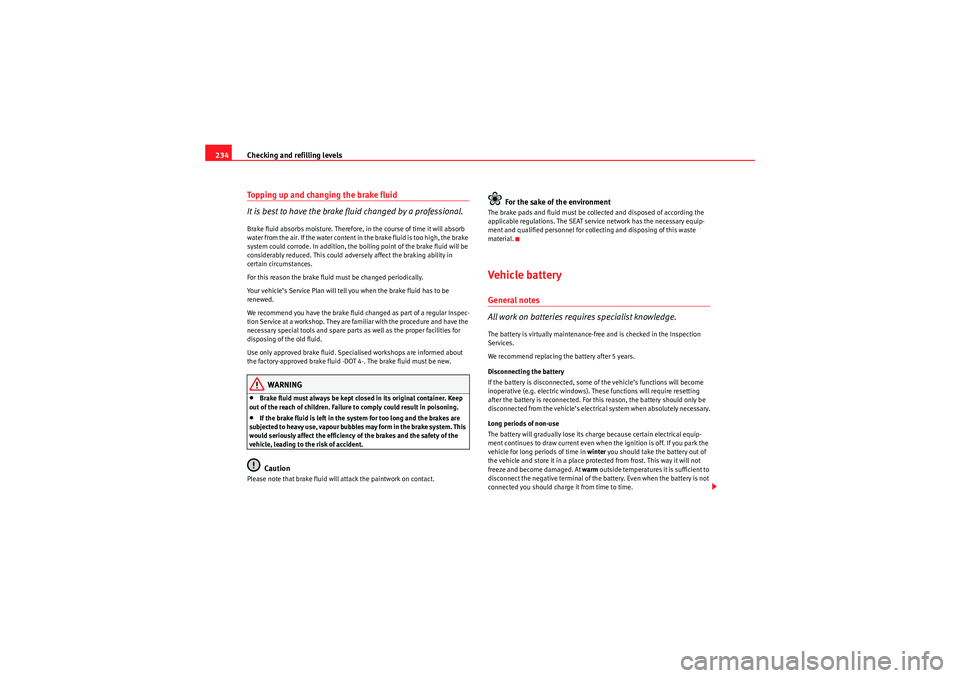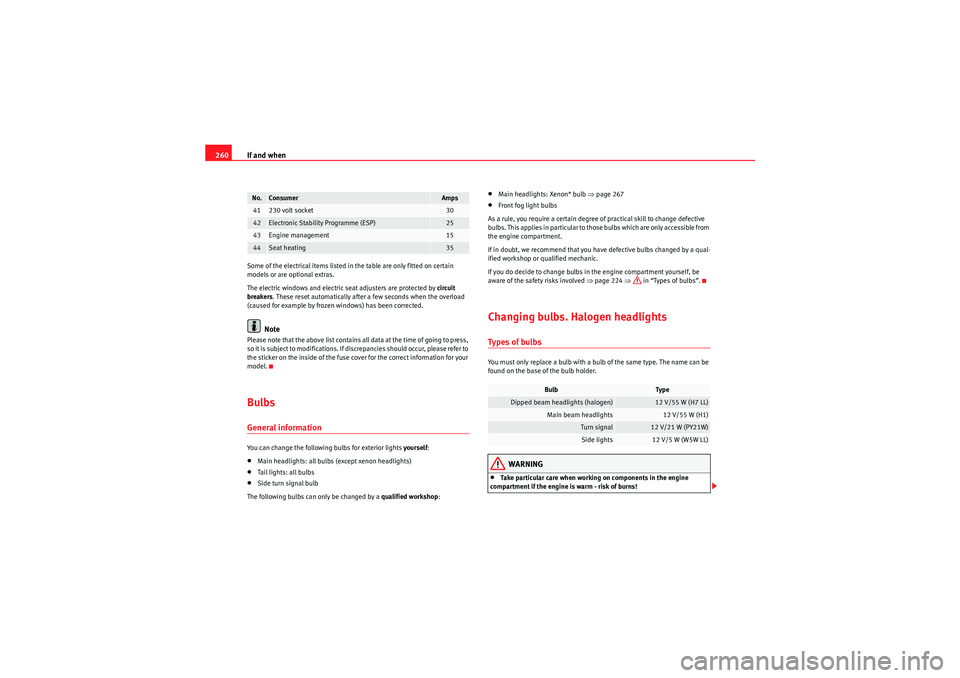reset Seat Exeo 2010 User Guide
[x] Cancel search | Manufacturer: SEAT, Model Year: 2010, Model line: Exeo, Model: Seat Exeo 2010Pages: 319, PDF Size: 9.64 MB
Page 161 of 319

Air conditioning159
Safety First
Operating Instructions
Practical Tips
Technical Specifications
The , and buttons (which regulate air distribution) can either be
selected individually or in combination.
Automatic mode
Standard setting for all seasons.Switching on automatic mode
– Select a temperature between +18°C (64°F) and +29°C (86°F).
– Press the button
⇒page 158, fig. 130 .The automatic mode maintains a constant temperature inside the vehicle and
dehumidifies the air. Air temperature, air delivery and air distribution are
regulated automatically to reach the desired interior temperature as quickly
as possible, and then to maintain this temperature. The system automatically
compensates for any variations in the outside temperature and for the effect
of direct sunlight.
The automatic temperature regulation only operates at temperature settings
between +18°C and +29°C. If a temperature below +18°C is selected, LO
appears on the display. If a temperature is selected which is higher than
+29°C, the display will show HI. In the maximum and minimum settings, the
climate control operates continuously with maximum cooling or heating output and the temperature is not regulated automatically. The temperature
is not regulated.
Note
By keeping the button on the driver side pressed for several seconds,
the temperature of the passenger side can be set to the temperature of the
driver side or vice versa. The display indicates the new temperature value.Selecting the temperature
Separate temperatures can be selected for the driver and
front passenger sides.– Press the or buttons below the displays
⇒page 158,
fig. 130 until the desired temperature is selected for the driver
side or front passenger side.The currently selected temperature setting is shown in the display above the
buttons.
By keeping the button on the driver side pressed for several seconds,
the temperature of the passenger side can be set to the temperature of the
driver side or vice versa. The display indicates the new temperature value. The
previous temperature setting can be restored by resetting the display on the
driver or passenger side as required.
(centre buttons)
Adjusts blower speedAir to the windowsAir from the dashboard outletsAir to the footwells
Button(s)
Meaning
-+
AUTO
AUTO
AUTO
-+
-
+
AUTO
exeo_EN.book Seite 159 Montag, 30. August 2010 4:45 16
Page 184 of 319

Driving
182Vehicles with tiptronic gearbox
When the accelerator pedal is pressed right down past the point of resistance
at full throttle, the gearbox will shift down to a lower gear, depending on road
speed and engine speed. The upshift to the next higher gear is delayed until
the engine reaches maximum rpm.
WARNING
P l eas e n o te t ha t i f t h e road s u r fa ce is s l i pp e r y o r w e t , t h e k ick- d ow n fe at u re
could cause the driving wheels to spin, which could result in skidding.Dynamic gear control programme (DCP)
The automatic gearbox is controlled electronically.The vehicle is equipped with an electronically controlled gearbox. The gear
ratios are selected automatically according to preset gearshift programmes.
When you drive at moderate speeds the gearbox will select the most econom-
ical shift programme. It will then change up early and delay the downshifts to
give better fuel economy.
If you drive at higher speeds with heavy acceleration, if you open the throttle
quickly, or if you use the kick-down or the vehicle’s maximum speed, the
gearbox will automatically select the sport programme.
The gearbox is self-adapting, and continuously selects the most suitable shift
programme. At the same time, the driver can also make the gearbox switch to
the sport programme by pressing the accelerator quickly. This makes the
gearbox shift down into a lower gear ratio, allowing a more rapid acceleration
(for instance to pass another vehicle), without having to press the accelerator
all the way down into the kick-down position. After the gearbox has shifted
back up it returns to the original programme, depending on your style of
driving. Vehicles with multitronic® gearbox: the gearbox continuously adapts the
gear ratios to gradients. If the brake
pedal is pressed on a downhill gradient
the gearbox automatically shifts to a lower gear ratio. This increases the
engine braking effect.
Vehicles with tiptronic gearbox: in mountainous areas, the gearbox adapts
the gears for uphill and downhill gradients. This helps to avoid constant gear
changes on uphill gradients.
exeo_EN.book Seite 182 Montag, 30. August 2010 4:45 16
Page 236 of 319

Checking and refilling levels
234Topping up and changing the brake fluid
It is best to have the brake fluid changed by a professional.Brake fluid absorbs moisture. Therefore, in the course of time it will absorb
water from the air. If the water content in the brake fluid is too high, the brake
system could corrode. In addition, the boiling point of the brake fluid will be
considerably reduced. This could adversely affect the braking ability in
certain circumstances.
For this reason the brake fluid must be changed periodically.
Your vehicle’s Service Plan will tell you when the brake fluid has to be
renewed.
We recommend you have the brake fluid changed as part of a regular Inspec-
tion Service at a workshop. They are familiar with the procedure and have the
necessary special tools and spare parts as well as the proper facilities for
disposing of the old fluid.
Use only approved brake fluid. Specialised workshops are informed about
the factory-approved brake fluid -DOT 4-. The brake fluid must be new.
WARNING
•Brake fluid must always be kept closed in its original container. Keep
out of the reach of children. Failure to comply could result in poisoning.•If the brake fluid is left in the system for too long and the brakes are
subjected to heavy use, vapour bubbles may form in the brake system. This
would seriously affect the efficiency of the brakes and the safety of the
vehicle, leading to the risk of accident.Caution
Please note that brake fluid will attack the paintwork on contact.
For the sake of the environment
The brake pads and fluid must be collected and disposed of according the
applicable regulations. The SEAT service network has the necessary equip-
ment and qualified personnel for collecting and disposing of this waste
material.Vehicle batteryGeneral notes
All work on batteries requires specialist knowledge.The battery is virtually maintenance-free and is checked in the Inspection
Services.
We recommend replacing the battery after 5 years.
Disconnecting the battery
If the battery is disconnected, some of the vehicle’s functions will become
inoperative (e.g. electric windows). These functions will require resetting
after the battery is reconnected. For this reason, the battery should only be
disconnected from the vehicle’s electrical system when absolutely necessary.
Long periods of non-use
The battery will gradually lose its charge because certain electrical equip-
ment continues to draw current even when the ignition is off. If you park the
vehicle for long periods of time in winter you should take the battery out of
the vehicle and store it in a place protected from frost. This way it will not
freeze and become damaged. At warm outside temperatures it is sufficient to
disconnect the negative terminal of the battery. Even when the battery is not
connected you should charge it from time to time.
exeo_EN.book Seite 234 Montag, 30. August 2010 4:45 16
Page 262 of 319

If and when
260Some of the electrical items listed in the table are only fitted on certain
models or are optional extras.
The electric windows and electric seat adjusters are protected by circuit
breakers . These reset automatically after a few seconds when the overload
(caused for example by frozen windows) has been corrected.
Note
Please note that the above list contains all data at the time of going to press,
so it is subject to modifications. If discrepancies should occur, please refer to
the sticker on the inside of the fuse cover for the correct information for your
model.BulbsGeneral informationYou can change the following bulbs for exterior lights yourself:•Main headlights: all bulbs (except xenon headlights)•Tail lights: all bulbs•Side turn signal bulb
The following bulbs can only be changed by a qualified workshop:
•Main headlights: Xenon* bulb ⇒page 267•Front fog light bulbs
As a rule, you require a certain degree of practical skill to change defective
bulbs. This applies in particular to those bulbs which are only accessible from
the engine compartment.
If in doubt, we recommend that you have defective bulbs changed by a qual-
ified workshop or qualified mechanic.
If you do decide to change bulbs in the engine compartment yourself, be
aware of the safety risks involved ⇒page 224 ⇒ in “Types of bulbs”.Changing bulbs. Halogen headlightsTypes of bulbsYou must only replace a bulb with a bulb of the same type. The name can be
found on the base of the bulb holder.
WARNING
•Take particular care when working on components in the engine
compartment if the engine is warm - risk of burns!
41
230 volt socket
30
42
Electronic Stability Programme (ESP)
25
43
Engine management
15
44
Seat heating
35
No.
Consumer
Amps
Bulb
Type
Dipped beam headlights (halogen)
12 V/55 W (H7 LL)
Main beam headlights
12 V/55 W (H1)
Turn signal
12 V/21 W (PY21W)
Side lights
12 V/5 W (W5W LL)
exeo_EN.book Seite 260 Montag, 30. August 2010 4:45 16